Related Research Articles
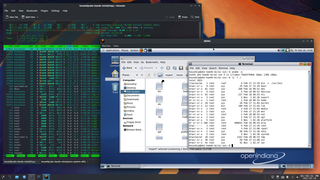
The Quick Emulator (QEMU) is a free and open-source emulator that uses dynamic binary translation to emulate a computer's processor; that is, it translates the emulated binary codes to an equivalent binary format which is executed by the machine. It provides a variety of hardware and device models for the virtual machine, enabling it to run different guest operating systems. QEMU can be used with a Kernel-based Virtual Machine (KVM) to emulate hardware at near-native speeds. Additionally, it supports user-level processes, allowing applications compiled for one processor architecture to run on another.

Arduino is an Italian open-source hardware and software company, project, and user community that designs and manufactures single-board microcontrollers and microcontroller kits for building digital devices. Its hardware products are licensed under a CC BY-SA license, while the software is licensed under the GNU Lesser General Public License (LGPL) or the GNU General Public License (GPL), permitting the manufacture of Arduino boards and software distribution by anyone. Arduino boards are available commercially from the official website or through authorized distributors.

Intel Galileo is the first in a line of Arduino-certified development boards based on Intel x86 architecture and is designed for the maker and education communities. Intel released two versions of Galileo, referred to as Gen 1 and Gen 2. These development boards are sometimes called "Breakout boards".
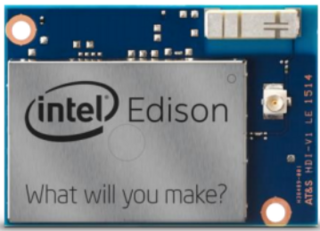
The Intel Edison is a computer-on-module that was offered by Intel as a development system for wearable devices and Internet of Things devices. The system was initially announced to be the same size and shape as an SD card and containing a dual-core Intel Quark x86 CPU at 400 MHz communicating via Bluetooth and Wi-Fi. A later announcement changed the CPU to a 500 MHz Silvermont dual-core Intel Atom CPU, and in September 2014 a second version of Edison was shown at IDF, which was bigger and thicker than a standard SD card.

The Arduino Uno is an open-source microcontroller board based on the Microchip ATmega328P microcontroller (MCU) and developed by Arduino.cc and initially released in 2010. The microcontroller board is equipped with sets of digital and analog input/output (I/O) pins that may be interfaced to various expansion boards (shields) and other circuits. The board has 14 digital I/O pins, 6 analog I/O pins, and is programmable with the Arduino IDE, via a type B USB cable. It can be powered by a USB cable or a barrel connector that accepts voltages between 7 and 20 volts, such as a rectangular 9-volt battery. It has the same microcontroller as the Arduino Nano board, and the same headers as the Leonardo board. The hardware reference design is distributed under a Creative Commons Attribution Share-Alike 2.5 license and is available on the Arduino website. Layout and production files for some versions of the hardware are also available.
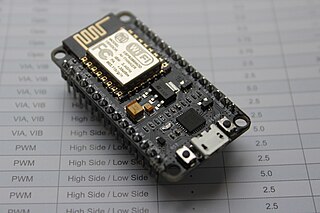
NodeMCU is a low-cost open source IoT platform. It initially included firmware which runs on the ESP8266 Wi-Fi SoC from Espressif Systems, and hardware which was based on the ESP-12 module. Later, support for the ESP32 32-bit MCU was added.
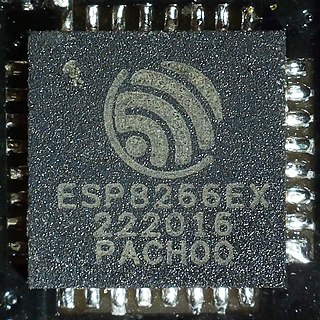
The ESP8266 is a low-cost Wi-Fi microcontroller, with built-in TCP/IP networking software, and microcontroller capability, produced by Espressif Systems in Shanghai, China.

Zephyr is a small real-time operating system (RTOS) for connected, resource-constrained and embedded devices supporting multiple architectures and released under the Apache License 2.0. Zephyr includes a kernel, and all components and libraries, device drivers, protocol stacks, file systems, and firmware updates, needed to develop full application software.

The Arduino Nano is an open-source breadboard-friendly microcontroller board based on the Microchip ATmega328P microcontroller (MCU) and developed by Arduino.cc and initially released in 2008. It offers the same connectivity and specs of the Arduino Uno board in a smaller form factor.
MicroPython is a software implementation of a programming language largely compatible with Python 3, written in C, that is optimized to run on a microcontroller.
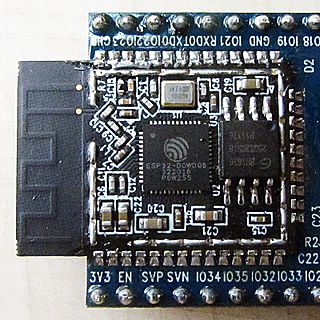
ESP32 is a series of low-cost, low-power system-on-chip microcontrollers with integrated Wi-Fi and dual-mode Bluetooth. The ESP32 series employs either a Tensilica Xtensa LX6 microprocessor in both dual-core and single-core variations, an Xtensa LX7 dual-core microprocessor, or a single-core RISC-V microprocessor and includes built-in antenna switches, RF balun, power amplifier, low-noise receive amplifier, filters, and power-management modules. It is commonly found either on device-specific PCBs or on a range of development boards with GPIO pins and various connectors depending on the model and manufacturer of the board.

MySensors is a free and open source DIY software framework for wireless IoT devices allowing devices to communicate using radio transmitters. The library was originally developed for the Arduino platform.
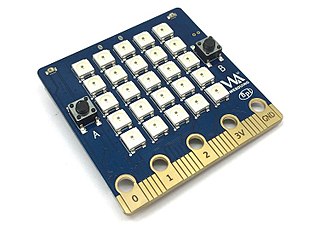
The BPI Bit is an ESP32 with Xtensa 32bit LX6 single/dual-core processor based embedded system

CircuitPython is an open-source derivative of the MicroPython programming language targeted toward students and beginners. Development of CircuitPython is supported by Adafruit Industries. It is a software implementation of the Python 3 programming language, written in C. It has been ported to run on several modern microcontrollers.
Marlin is open source firmware originally designed for RepRap project FDM 3D printers using the Arduino platform.

RP2040 is a 32-bit dual ARM Cortex-M0+ microcontroller integrated circuit by Raspberry Pi Ltd. In January 2021, it was released as part of the Raspberry Pi Pico board. Its successor is the RP2350 series.

FatFs is a lightweight software library for microcontrollers and embedded systems that implements FAT/exFAT file system support. Written on pure ANSI C, FatFs is platform-independent and easy to port on many hardware platforms such as 8051, PIC, AVR, ARM, Z80. FatFs is designed as thread-safe and is built into ChibiOS, RT-Thread, ErlendOS, and Zephyr real-time operating systems.
References
- ↑ http://www.pedroliveira.pt/home-domotics-internet-things-part-one/ Archived 2016-11-06 at the Wayback Machine Home Domotics + Internet of Things Part One
- ↑ Brown, Eric (2016-09-27). "Linux and Open Source Hardware for IoT". Linux.com. Retrieved 2024-03-27.
- ↑ "Part 2 OpenHAB, MQTT, and ESP Easy - Build Your Own DIY Node". Instructables. Retrieved 2024-03-27.
- ↑ "(Polski) Domoticz ESP8266 DHT22 | Let's play with the technology". blog.jokielowie.com. 2016-02-09. Retrieved 2024-03-27.
- ↑ "ESPEasy - MultiSensor Node for ESP8266 Modules - Part 1". Hackster.io. Retrieved 2024-03-27.
- ↑ "ESP8266 - Easiest way to program so far (Using Arduino IDE)". What I Made Today. 2015-04-22. Retrieved 2024-03-27.
- ↑ http://www.my-iota.com/Development%20boards/Witty%20Cloud%20(GizWits)%20-%20ESP8266%20Development%20Board/Witty%20Cloud%20(GizWits)%20-%20ESP8266%20Development%20Board.pdf Archived 2016-09-19 at the Wayback Machine Witty Cloud / GizWits - ESP8266 Development Board
- ↑ http://www.my-iota.com/ESP%20Easy%20Firmware/ESP%20easy%20firmware.htm Archived 2016-10-11 at the Wayback Machine ESP Easy firmware
- ↑ https://www.linuxfestnorthwest.org/sites/default/files/slides/Internet%20of%20Thingies.pdf Archived 2016-09-20 at the Wayback Machine LinuxFest Northwest 2016 Internet of Thingies - The OpenNMS Group
- ↑ "Experimental: ESP Easy MySensors Edition". MySensors Forum. 2015-12-09. Retrieved 2024-03-27.
- ↑ "Mikeys Notes". Mikeys Notes. 2022-12-25. Retrieved 2024-03-27.
- ↑ http://www.inventech.co.za/product/wifiswitch/ Archived 2016-09-16 at the Wayback Machine Inventech WiFi Switch
- ↑ http://www.letscontrolit.com/index.php#ESPEasy LetsControlIt - ESP Easy
- ↑ https://nathan.chantrell.net/20160422/esp8266-relay-modules-from-itead-and-electrodragon/ Archived 2016-10-20 at the Wayback Machine ESP8266 Relay Modules from Itead and Electrodragon
- ↑ "ESPEasy installation on ESP8266 (preliminary to domoticz)". Get To Know The Bob. 2016-05-08. Retrieved 2024-03-27.
- ↑ Cross, Andrew (2015-09-23). "The ESP8266 Wifi Chip: Part 3 – Flashing Custom Firmware". AGCross.com. Retrieved 2024-03-27.
- ↑ "Esp8266 Firmware Update". Instructables. Retrieved 2024-03-27.
- ↑ "Introduktion till ESP8266, del 1 – Bakgrund och mjukvara". blog.m.nu (in Swedish). 2016-03-24. Retrieved 2024-03-27.
- ↑ http://captain-slow.dk/2016/05/22/replacing-the-itead-sonoff-firmware/ REPLACING THE ITEAD SONOFF FIRMWARE
- ↑ "ESP8266 3 Channel Solid State Wifi Switch by Inventech on Tindie". Tindie. Retrieved 2024-03-27.
- ↑ http://iothyngs.com/?page_id=125 IoThyng
- ↑ http://www.projetsdiy.fr/esp-easy-esp8266-wemos-d1-mini-mqtt/ Archived 2016-10-11 at the Wayback Machine ESP Easy + Jeedom : objets connectés ESP8266 simplifiés
- ↑ Robin (2016-03-16). "ESPEasy: Administrationsoberfläche für ESP8266 für IoT und Fhem". Robins Blog - Technik und Multimedia (in German). Retrieved 2024-03-27.